India is known for its rich and diverse cultural heritage, with annual festivals playing a major role in showcasing this cultural richness. Popular Indian festivals attract countless travellers every year, providing an opportunity to immerse yourself in the heart of Indian culture.
From colourful processions and traditional dances to music performances and religious rituals, festivals provide a firsthand experience of India's traditions and customs. India is home to many different religions, and festivals are an integral part of their various religious observances and traditions.
| Festival | 2024 Date | 2025 Date |
|---|---|---|
| Holi | March 25 | March 13 |
| Eid-ul-Fitr | April 10 | March 31 |
| Ganesh Chaturthi | September 6 | September 26 |
| Onam | September 15 | September 5 |
| Durga Puja | October 9-12 | September 30-October 4 |
| Dussehra | October 12 | October 2 |
| Diwali | October 31 | October 21 |
Iconic festivals such as Diwali, Holi, and Durga Puja showcase the vibrancy of India's cultural tapestry, making them a top bucket list item for Aussie travellers seeking an unforgettable cultural experience. Discover the richness and diversity of the Indian cultural heritage through its festivals by exploring the top annual festivals.
Don't let any surprises rain on your parade - remember to consider travel insurance for added peace of mind, ensuring your Indian festivals are joyful occasions filled with laughter, smiles, and memorable moments. Whether you’re looking at the Indian festivals calendar 2024 or planning ahead for Indian festivals in 2025, there’s always something unforgettable to experience.
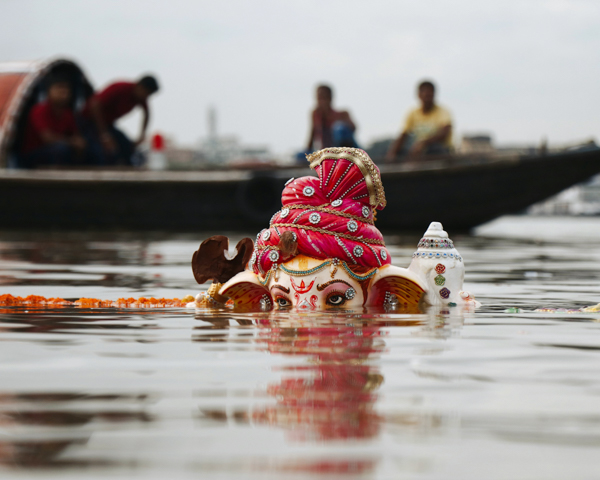
Dussehra
Held around the same time of year as Onam and Ganesh Chaturthi is Dussehra, also known as Vijayadashami. It celebrates the victory of Lord Rama over the demon king Ravana. Dussehra is often celebrated with elaborate theatrical performances called Ram Lila, which depict the life and deeds of Lord Rama, particularly the epic battle between Rama and Ravana.
You can easily attend Ram Lila performances held in various cities, towns, and villages across India, where actors enact scenes from the Ramayana, culminating in the burning of effigies of Ravana, his brothers, and his son Meghnad.
During Dussehra, you’ll find colourful processions, parades, and lively fairs in various cities, towns, and villages around India. You may also want to visit temples dedicated to Lord Rama, Goddess Durga, or other deities associated with Dussehra to further celebrate the festival and its spiritual significance.
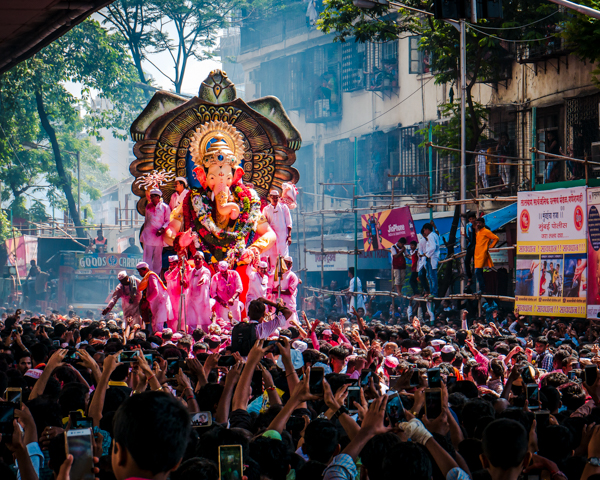
Diwali
Diwali, also known as the Festival of Lights, is one of the most widely celebrated Hindu festivals in India. Occurring over about a week-long period every autumn, it celebrates the victory of good over evil. Leading up to Diwali, homes and streets are adorned with colourful decorations, oil lamps known as ‘diyas’, and intricate floor designs known as ‘rangoli’ made from coloured powders or flowers, symbolising prosperity and welcome.
Diwali is a time for shopping and buying souvenirs, with markets and bazaars bustling with activity as people purchase new clothes, gifts, sweets, and decorative items for their homes.
Diwali is also a time for sampling all kinds of delicious local food and sweets including ‘mithai’ and ‘namkeen’. You can also expect to witness plenty of fireworks lighting up the night sky, symbolising the victory of light over darkness, good over evil. You’ll find that many cities and towns organise cultural events, music concerts, dance performances, and theatre shows to celebrate the festival, making it a time for communities to come together, celebrate, and create lasting memories. Happy Diwali 2024!
Holi
Known as the Festival of Colours, Holi is undoubtedly one of the most vibrant and joyous festivals celebrated throughout India. It marks the arrival of spring, bringing with it new beginnings and renewed energy, and once again the victory of good over evil, emphasising hope and positivity.
Holi has deep roots in Hindu mythology and is associated with various legends - primarily the legend of Prahlada and Hiranyakashipu or the love story of Radha and Krishna. As Holi approaches, markets come alive with the sale of vibrant coloured powders, known as gulal, and festive balloons.
The festival begins with Holika Dahanon, held the night before the main day of Holi. Bonfires are lit to symbolise the burning of Holika, the demoness, and the victory of good over evil. Bonfires are burned to commemorate the burning of Holika, the demoness, symbolising the triumph of good over evil.
The main day of Holi, known as Rangwali Holi, is characterised by colourful celebrations where locals gather in streets and parks to play with coloured powders and water balloons while dancing to traditional Holi songs.
While Holi is a memorable and immersive experience, be prepared to get wet and stained with colours, so make sure you pack and wear old or inexpensive clothes you don’t mind getting colourful!
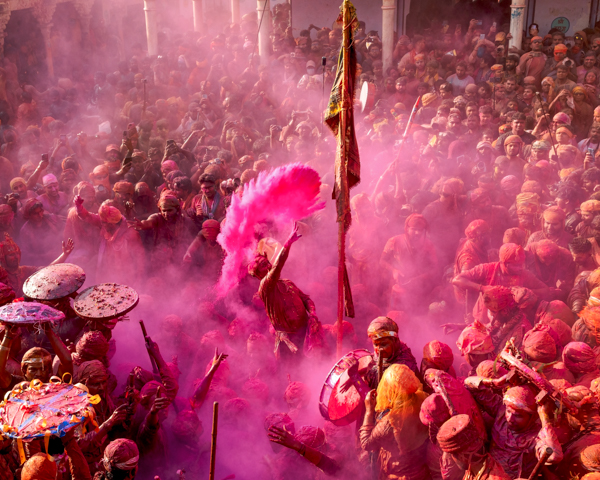
Durga Puja
Another Hindu festival, Durga Puja, also known as Durgotsava or Sharodotsav, continues the theme of celebrating good over evil, more specifically in this case the victory of the goddess Durga over the demon Mahishasura. The festival is especially popular in eastern India, with Kolkata, the capital of West Bengal, being one of the best places to witness the grand celebrations.
The festival lasts well over a week, with local artisans creating elaborate clay idols of Goddess Durga and her family. Temporary bamboo structures, known as pandals, are erected in neighbourhoods to house these idols before the idols are eventually plunged into rivers at the end of the festival, signifying the goddess’s return to her celestial abode.
Viewing the various pandals with their idols is one of the main highlights of Durga Puja celebrations, and visiting the various ones is known as pandal hopping. Many pandals organise cultural programs, including music concerts, dance performances, drama, and recitals. You will often be able to enjoy live performances showcasing both traditional and contemporary art forms of India.
Durga Puja is also a time for feasting and indulging in delicious Bengali cuisine. Street stalls and food vendors offer a variety of traditional dishes:
- Luchi: Deep-fried bread
- Alur Dom: Spiced potato curry
- Cholar Dal: Bengal gram lentils
- Kosha Mangsho: Slow-cooked mutton
- Sweets like Rosogolla, Sandesh, and Mishti Doi add sweetness to the festivities.
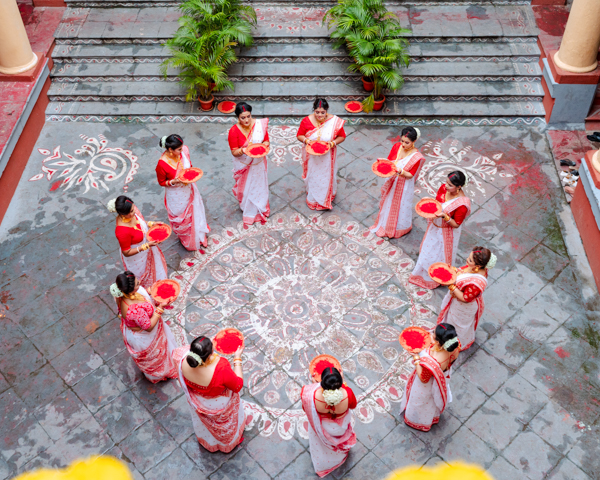
Ganesh Chaturthi
Ganesh Chaturthi is the Hindu festival that honours the birth of Lord Ganesha, the elephant-headed god of wisdom, prosperity, and the remover of obstacles. It is one of the most widely celebrated festivals in India, particularly in the western states of Maharashtra, Goa, Gujarat, and Karnataka. The ten-day festival will take place at the beginning of September this year.
Unsurprisingly, you can expect to see plenty of Lord Ganesha sculptures in the various temples and makeshift pandals erected for the festival. On the first day of the festival, the idol of Lord Ganesha is ceremoniously installed and worshipped with prayers, chanting of mantras, and offerings of flowers, fruits, and traditional sweet delicacy known as ‘modak’.
The festival ends with the submersion of the Ganesha idols in rivers, lakes, or the sea, much like the fate of the idols of the Durga Puja festival. This ritual, known as Ganesh Visarjan, symbolises the farewell of Lord Ganesha as he returns to his heavenly abode.
Ganesh Chaturthi is celebrated with great pomp in many cities and towns across India. During the Ganesh Visarjan, processions attract thousands of people, especially in cities like Mumbai and Pune.
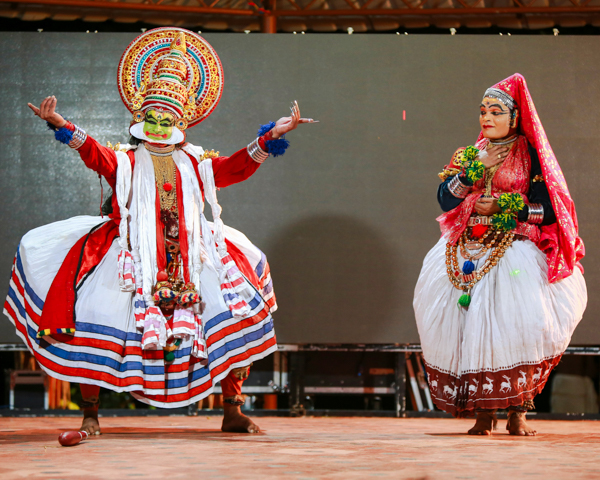
Onam
If you’re already planning on visiting Ganesh Chaturthi, then you may as well stick around for Onam, which is also held in September. Onam is primarily celebrated in the southern state of Kerala. It is one of the most important festivals in Kerala and holds great cultural and religious significance. Onam is a harvest festival, marking the homecoming of the mythical King Mahabali and the beginning of the harvest season.
The festival includes intricate flower carpets called Pookalam. Special rangoli patterns made from coloured powders and flowers adorn the entrances of homes. One of the highlights of Onam is the Onam Sadya which is often offered by hotels and restaurants. It is a grand feast served on banana leaves that typically includes a variety of traditional Kerala dishes such as avial, olan, thoran, sambar, rasam, and payasam.
Onam celebrations feature traditional performances such as Pulikali tiger dance, where Pulikali performers paint themselves as tigers and dance through the streets. The festival also includes the chance to watch vallam kali or snake boat races in the backwaters of Kerala.
Eid-ul-Fitr
While it’s not mandatory for non-Muslim travellers, observing Ramadan can provide valuable insights into Islamic traditions, culture, and spirituality. Fasting during Ramadan allows you to experience the discipline and devotion of this sacred period.
On the morning of Eid-ul-Fitr, Muslims gather in mosques and prayer grounds to perform special prayers known as Salat al-Eid. Travellers can join in these prayers to experience the spiritual significance and communal atmosphere of Eid celebrations.
Eid-ul-Fitr is celebrated with elaborate feasts and hospitality, with local Indian families preparing and sharing special local delicacies such as biryani, kebabs, sheer khurma, and sweets like baklava, jalebi, and gulab jamun.
The festival is also a time for giving back. Zakat al-Fitr, or the charity of breaking the fast, is an important aspect of Eid-ul-Fitr. It’s a time to seek out and immerse yourself in charitable causes or donate to local organisations to support the less fortunate.
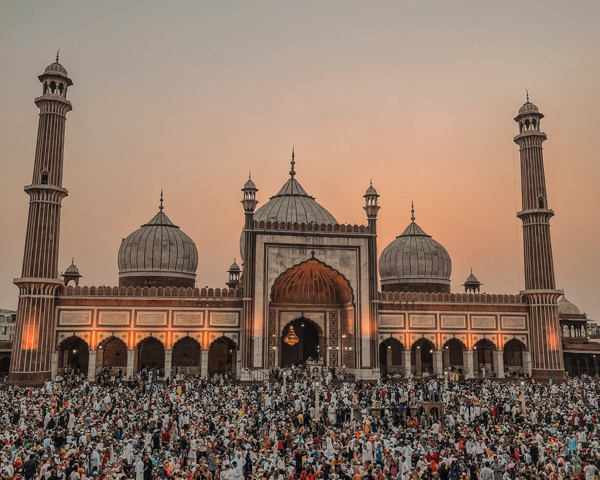
With that said, the cultural journey does not end there. India is also home to some of the world's iconic landmarks. The Taj Mahal, a UNESCO World Heritage Site and one of the Seven Wonders of the World, symbolises love and architectural superiority. Another must-see is Delhi's Red Fort, an engineering masterpiece that reflects the grandeur of the Mughal Empire.
